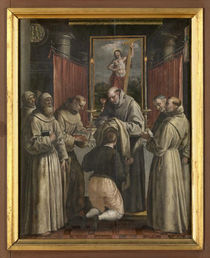The Catholic Defender: Saints Marcellinus and Peter
- Donald Hartley

- Jun 1
- 3 min read
Updated: Jun 2
Deepertruth with special permission and aid with Franiciscan Media, a great team for the Lord

Tradition tells us that Marcellinus was a priest and Peter an exorcist and that they were beheaded on the outskirts of Rome. A few years after the bloody event, a little boy from Rome heard about their deaths from the mouth of their very executioner, who later became a Christian.
It was at the mid-point of this persecution, around 303, that a Roman exorcist by the name of Peter was imprisoned for his faith. While in prison, tradition holds that Peter freed Paulina, the daughter of the prison-keeper Artemius, from demonic influence by his prayers.
This demonstration of Christ's power over demons is said to have brought about the conversion of Paulina, Artemius, his wife, and the entire household, all of whom were baptized by the Roman priest Marcellinus.
The catacomb of Saints Marcellinus and Peter derives its name from the two martyrs buried within it. The story behind the life of these two martyrs goes back to the time of the Emperor Diocletian. St Marcellinus and St Peter were slain during the persecution of 304 AC - beheaded, in Rome.
Pope Damasus I claimed that he heard the story of these two martyrs from their Sts. Marcellinus and Peter
Damasus states that they were killed at an out-of-the-way spot by the magistrate Severus or Serenus, so that other Christians would not have a chance to bury and venerate their bodies.

The two saints happily cleared the spot chosen for their death: a thicket overgrown with thorns, brambles, and briers three miles from Rome. They were beheaded and buried in that spot.
Both men were beheaded in the forest and buried in the clearing they had made. The location of the saints' bodies remained unknown for some time, until a devout woman named Lucilla received a revelation informing her where the priest and exorcist lay.
With the assistance of another woman, Firmina, Lucilla recovered the two saints' bodies and had them re-interred in the Roman Catacombs. Sts. Marcellinus and Peter are among the saints named in the Western Church's most traditional Eucharistic prayer, the Roman Canon.
Pope St. Damasus I, who was himself a great devotee of the Church's saints during his life, composed an epitaph to mark the tombs of the two martyrs. The source of his knowledge, he said, was the executioner himself, who had subsequently repented and joined the Catholic Church.
Two women, Lucilla and Firmina, assisted by divine revelation, found the bodies, however, and had them properly buried.
Marcellinus and Peter were prominent enough in the memory of the Church to be included among the saints of the Roman Canon. Mention of their names is optional in our present Eucharistic Prayer I.
Marcellinus was a priest and Peter was an exorcist, that is, someone authorized by the Church to deal with cases of demonic possession. They were beheaded during the persecution of Emperor Diocletian.
Pope Damasus wrote an epitaph apparently based on the report of their executioner, and Constantine erected a basilica over the crypt in which they were buried in Rome. Numerous legends sprang from an early account of their death.
Why are these men included in our Eucharistic prayer, and given their own feast day, in spite of the fact that almost nothing is known about them?
Probably because the Church respects its collective memory. They once sent an impulse of encouragement through the whole Church. They made the ultimate step of faith.





















Comments